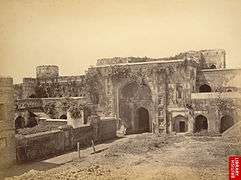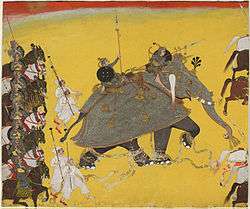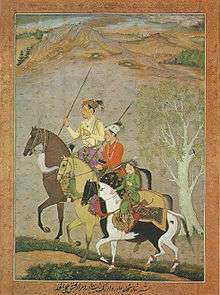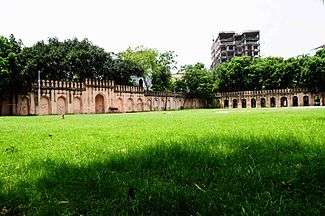Shah Shuja (Mughal prince)
| Shah Shuja | |
|---|---|
| Mughal Prince | |
 Portrait of Shah Shuja | |
| Born |
23 June 1616 Ajmer |
| Died |
7 February 1661 (aged 44) near Myohaung (Mrauk-U), Arakan |
| Spouse |
Bilqis Begum1657died Piari Banu Begum(1625-1656) a daughter of Raja Gur Sen, Raja of Kishtwar |
| Issue |
Zain-ul-Din Muhammad(1640-1661) Buland Akhtar Zainul Abidin(1651-1661) Dil Pazir Banu Begum(1649-1673) Gulrukh Banu Begum(1649-1663) Roshanara Begum Amina Banu Begum(1660-1696) |
| Dynasty | Timurid |
| Father | Shah Jahan |
| Mother | Mumtaz Mahal |
| Religion | Islam |
Shah Shuja (23 June 1616 – 7 February 1661)[1] was the second son of the Mughal emperor Shah Jahan and empress Mumtaz Mahal.her daughter princess pazir banu begum was married to Aurangzeb
Early life and family

Shah Shuja was born on 23 June 1616, in Ajmer. He was the second son and child of Mughal emperor Shah Jahan and his queen Mumtaz Mahal.
Shuja's siblings were Jahanara Begum, Dara Shikoh, Roshanara Begum, Aurangzeb, Murad Baksh, Gauhara Begum and others. He had three sons - Sultan Zain-ul-Din (Bon Sultan or Sultan Bang), Buland Akhtar and Zainul Abidin and four daughters - Gulrukh Banu, Roshanara Begum and Amina Begum.[2]
Marriage
He married to princess paira banu begum,daughter of raja gur sen of khihtwar and biqis begum
Governor of Bengal
Shuja was appointed by Shah Jahan as the Subahdar of Bengal and Bihar from 1641 and of Orissa from 25 July 1648 until 1661.[1][3] During his governorship, he built the official residence Bara Katra in the capital Dhaka.[4]
After the illness of Shah Jahan in September 1657, a power crisis occurred among the brothers. Shah Shuja proclaimed himself as Emperor, but Aurangzeb ascended the throne of Dheli and sent Mir Jumla to subjugate Shuja.[5] Shuja was defeated in the Battle of Khajwa on 5 January 1659.[1] He retreated first to Tandah and then to Dhaka on 12 April 1660.[1] He left Dhaka on 6 May and boarded ships near present-day Bhulua on 12 May heading Arakan.[1] Mir Jumla reached Dhaka on 9 May 1660 and was then appointed by Aurangzeb as the next Subahdar of Bengal.[5]
Construction projects in Dhaka
-

Bara Katra
-
.jpg)
An etching of Bara Katra by Sir Charles D'Oyly in 1823
Mughal war of succession


When Shah Jahan fell ill, a struggle for the throne started between his four sons - Dara Shikoh, Shah Shuja, Aurangzeb and Murad Baksh. Shuja immediately crowned himself the emperor and took imperial titles, November 1657.
He marched with a large army, backed by a good number of war-boats in the river Ganges. However, he was beaten by Dara's army in a hotly contested Battle of Bahadurpur near Banares (in modern Uttar Pradesh, India). Shuja turned back to Rajmahal to make further preparations. He signed a treaty with his elder brother Dara, which left him in control of Bengal, Orissa and a large part of Bihar, 17 May 1658.
In the meantime, Aurangzeb defeated Dara twice (at Dharmat and Samugarh), caught him, executed him on a charge of heresy and ascended the throne. Shuja marched again to the capital, this time against Aurangzeb. A battle took place on 5 January 1659 at the Battle of Khajwa (Fatehpur district, Uttar Pradesh, India) where Shuja was defeated.[6]
After his defeat, Shuja retreated towards Bengal. He was pursued by the imperial army under Mir Jumla. Shuja put up a good fight against them. However, he was finally defeated in the last battle in April 1660. After each defeat he had to face desertions in his own army, but he did not lose heart. He, rather, reorganised the army with renewed vigor. But when he was going to be surrounded at Tandah, and when he found that reorganisation of the army was no longer possible, he decided to leave Bengal for good and take shelter in Arakan.
Military promotions
- 1636 - 5000(20)
- 1641 - 30,000(25)
- 1646 - 36,000(30)
- 1653 - 40,000(37)
- 1655 - 43,000(39)
Asylum in Arakan
En route to Arakan
Shuja left Tandah with his family and retinue in the afternoon of 6 April 1660 and reached Dhaka on 12 April. He left Dhaka on 6 May and boarded the Arakanese ships on 12 May at Bhulua (near present-day Noakhali, Bangladesh).
Shuja first arrived at Chittagong and stayed for some time, from where he took the land route to Arakan which is still called Shuja Road. Thousand palanquins (carriers) carried the harem ladies and Shuja prayed Eid prayer at a place Edgoung (Eidgah) in Dulahzara which is still in Chittagong on the way to Arakan.
Shuja undertook the land journey for 13 days and 13 nights with a troubled mind on the eastern bank of Naf River, half a mile north of Maungdaw town which is still known as Shuja village. Some of Shuja’s retinues there were later retained by the British army as archers army since 1826.
Conspiracy of Arakan King
The final day on sea route took Shuja to Arakan where he was received by an envoy of Arakan king Sanda Thudhamma and escorted to a separate quarter for the Mughal prince. Niccolao Manucci wrote: "The date of flight (of Shuja from Dacca) was June 5, 1660 and arrived in Arakan on August 26, 1660."[7] Harvey noted that Shuja came to Arakan as Sanda Thudhamma promised to provide him some of his famous ships to take him to Mecca for pilgrimage. but He broke the promise. When Shuja arrived in Arakan with half a dozen camel loads of gold and jewelry, the temptation was too great for the Arakan king.
They ran amok, nearly succeeded in firing the royal palace of Sanda Thudhamma in December 1660, while many Mughals were massacred.[8] After escaping from the capital, in the jungles near Mrohaung, Arakan, it is said that Shuja was killed by pursuers dispatched by King Sandathudamma, 7 February 1661.[3] Shuja's three sons were captured on same day, and they werre beheaded with a blunt axe at Mrohaung, ca 25 July 1663, following an abortive rescue by the Subadar of Bengal.[3]
Prince Shah Shuja's daughter Princess Gulrukh Banu Begum was raped by Sanda Thudhamma and committed suicide on ca 25 July 1663,[9] while Sultan Bang and another brother died fighting.
The Portuguese who were famous there as pirates did save Shuja while robbed him of gold and jewels, these misfortunate events had a very profound critical breakdown effect on Shah Shuja. The surviving Mughals with Shuja escaped back to Tripura on 16 May 1661 with much difficulty[7] and arrived in Manipur in December 1661.[10]
While Aurangzeb’s reconnaissance men were on the hunt for Shuja and for every bit of news.[11] Conscious of this, Shuja’s men spread false news that Shuja died fighting in Arakan, while others rumoured he shipped to Mecca. There were a thousand different tales about Shuja’s fate and nothing could be conclusive.[7]
Fleeing to Manipur

On the breach of trust by Arakan king Sanda Thudhamma, Shuja fled back to Tripura whose king quickly dispatched Shuja to Manipur in 1661 so that it might not antagonize the military force of Aurangzeb led by Mir Jumla II.
The Mughals lately came to know of the situation but Shuja was already gone. Shah Shuja reached Manipur in December 1661 according to Cheitharol Kumbaba.[12] The Mughals sent a three men embassy to Manipur in late December 1661, this time to retrieve the aggrieved family of Shuja.[13] At that time Shuja was taking shelter in at Haignang of Kairang (east of Imphal), now known as Shuja-lok (Shuja cave).[11]
Mughals enthroned Chhatra Manikya (ruling 1661-66) in Tripura while Govinda Manikya too fled to Arakan where he again met Shuja.[14] In the meantime in Tripura, Chhatra Manikya was too dethroned and Govinda Manikya came back from Arakan to claim the throne and ruled Tripura again from 1667 to 1675.[15]
The Manipur king Khunjaoba sent back a three-man embassy to the court of the Mughal emperor Aurangzeb in 1662.[16] A Mughal ambassador, Nur Beg, was held back in Manipur by the Qazi of Manipur, Muhammad Sani. It was done so that the retreating two Mughal commanders named Dur Beg and Rustam Beg should tell about Shuja’s existence in Manipur.[17] Yet, Shuja was sent up to Ukhrul hill with some Muslims (already settled in Manipur) as precautionary measure from Mughal informers. Thus Tripura and Manipur kings played crucial roles in saving the life of Shah Shuja and his family.
See also
| Wikimedia Commons has media related to Shah Shuja. |
References
- 1 2 3 4 5 Abdul Karim. "Shah Shuja". Banglapedia. Retrieved 2013-01-24.
- ↑ Stanley Lane-Pool, 1971, Aurangzeb, vol.1.
- 1 2 3 delhi6
- ↑ Ayesha Begum. "Bara Katra". Banglapedia. Retrieved 2013-01-24.
- 1 2 Abdul Karim. "Mir Jumla". Banglapedia. Retrieved 2013-01-30.
- ↑ Battle of Khajwa
- 1 2 3 Niccolao Manucci, Storia do Mogor or History of Mughal India, translator William Irvine
- ↑ https://books.google.com/books?id=AV--abKg9GEC&pg=PA318&lpg=PA318&dq=Gulrukh+Banu&source=bl&ots=iI-jQ2IE3e&sig=Pl9_DYbWfN7JSzzOuEt4j6L4Oes&hl=en&sa=X&ei=iwQQUIC2H6iYmQWCpoGQCQ&ved=0CDkQ6AEwAQ#v=onepage&q=Gulrukh%20Banu&f=false
- ↑ S. Harvey, 1971, Burma; Suhas Chatterjee, 2008.
- ↑ Cheitharol Kumbaba, 1989.
- 1 2 Janab Khan, 1972, Manipuri Muslim.
- ↑ Cheitharol Kumbaba, p.45.
- ↑ A. Hakim Shah, 2008, The Manipur Governance.
- ↑ Roychoudury, p. 29:(According to traditions in Tripura, Govinda Manikya after losing throne to Nakshatra Roy, fled to Arakan where he met Shah Shuja whom he presented a precious sword and a diamond, and thus friendship was established).
- ↑ N.R. Roychoudhury, Tripura Through The Ages.
- ↑ A. Hakim Shah, 2008, The Manipur Governance
- ↑ Names of Mughal ambassadors can be known from P. Gogoi, 1961, The Tai and Tai Kingdoms who gave Dur Beg and Rustam; Kheiruddin Khullakpam, 1997, Turko-Afghangi Chada Naoda, Lilong: Circles, gives the Boggy clan ancestor as Noor Bakhsh that must be Noor Beg.
Further reading
- JN Sarkar (ed), History of Bengal, vol II, Dhaka, 1948
- JN Sarkar, History of Aurangzib, vol II, New Delhi, 1972–74
- A Karim, History of Bengal, Mughal Period, vol II, Rajshahi, 1995

